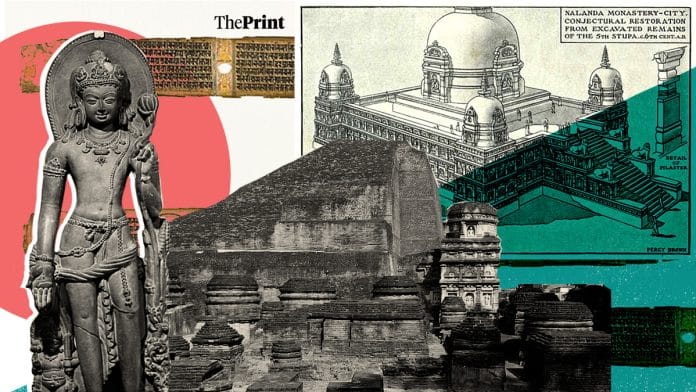Xuanzang tells his biographer Hwui Li—‘The priests, belonging to the convent, or strangers (residing therein) always reach to the number 10,000…there are 1000 men who can explain 20 collections of Sutras and Sastras; 500 men who can explain 30 collections, and perhaps 10 men including the master of law who can explain 50 collections. Silabhadra alone has studied and understood the whole number.’ Yijing records in his memoir that the number of monks staying at the monastery exceeded 3,000.
Commenting on the figures provided by Xuanzang and Yijing regarding the number of students at Nalanda Mahavihara, Frederick Asher writes:
‘If the reports that there were 3000–10,000 monks at the monastery were accurate, Nalanda must have had a dynamic relationship with the surrounding agricultural region, and not just with the surrounding towns. It is undeniable that the surrounding region prospered substantially from the endowment wealth of the monastery, however Nalanda in turn was also heavily dependent on goods and services from the surrounding region. Monasteries produce scholarship; however, they don’t produce any goods or services other than ritual services but are rather exclusively consumers. Just to feed 3000 monks from Yijing’s estimate, food alone would have been a huge enterprise. If each monk ate even half a kilogram of food per day, it would require 1.5 tons of food daily to feed 3000 monks. That is far more than the surrounding agricultural area could provide. However, we also need to think about the fact that the surrounding area and Magadha in general was a highly fertile region. These areas could produce as many as three crops per year, reducing the need to bring food from other faraway places In fact, one reason for the success of Nalanda monastery is attributed to the region’s ability to supply large amounts of food to large, concentrated populations of monks. The area around the monastery was also known for having a number of lakes and water bodies.’
Also read: How Buddhists lost out to Brahmins in Nalanda. Even before the Turks came
Admission Process
Nalanda was famous for its specialization in the art of disputation and public speaking. Xuanzang writes, ‘Foreign monks came to the establishment to put an end to their doubts and then became celebrated.’ Indian and foreign monks from distant places like China, Korea, Tibet and Tokhara (Bactria) came to India to study at Nalanda, and to copy valuable Buddhist manuscripts. Fifty-six Chinese and Korean monks visited India; during the span of forty years between the visits of Xuanzang and Yijing, many of them visited Nalanda. As noted by Xuanzang, ‘those who stole the name of Nalanda were all treated with respect wherever they went’.
The dvarapandit (Scholar at the gate) engaged in debates with the monks who wanted to study at Nalanda Mahavihara. A large number of them were turned back. ‘The keeper of the gate poses some difficult questions; many are unable to answer and retire’ Xuanzang notes. He adds, ‘Of those from abroad who wished to enter the schools of discussion the majority, beaten by the difficulties of the problems, withdrew; and those who were deeply versed in old and modern learning were admitted, only two or three out of ten succeeding.’
According to Yijing, ‘A student at 15 had to study Vritti-sutra which he finished at 20, after which he studied philosophy for two or three years at advanced institutions like Nalanda or Vallabhi.’ Thus, it can be said that the students seeking admission at Nalandamust have been in their twenties and above.
Intellectual Life
Xuanzang writes in his book Buddhist Records of the Western Countries:
‘The priests, to the number of several thousands, are the men of highest ability and talent. Their distinction is great at the present time and there are many hundreds whose fame has rapidly spread through distant regions. Their conduct is pure and unblamable. They sincerely follow the precepts of moral law. The rules of the convent are severe, and all the priests are bound to observe them. The countries of India respect and follow them. The day is not sufficient for asking and answering profound questions. From morning till night they engage in discussion, the young and the old mutually help one another. Those who cannot discuss questions out of Tripitaka are little esteemed and are obliged to hide themselves for shame. Learned men from different cities, on this account, who desire to acquire quickly a renown indiscussion, come here in multitudes to settle their doubts, and then the streams of their wisdom spread far and wide.’
Several lectures and disputations went on simultaneously in the central courtyards of the monasteries and monks actively participated in them. Xuanzang tells his disciple Hwui Li, ‘Within the Temple, they arrange 100 pulpits for preaching, and the students attend these discourses without any fail, even for a minute.’
 This excerpt from Nalanda: How It Changed The World by Abhay K has been published with permission from Penguin Random House India.
This excerpt from Nalanda: How It Changed The World by Abhay K has been published with permission from Penguin Random House India.







How are they priests? Are they not Buddhist monks? Did the Chinese traveler mention in his travelogue that these are priests?
Unfortunately Nalanda university got closed due to complaint received regarding cheating and question paper leakage during early 8th century ,it seems that even one thousand five hundred years ago ,the locals were past masters and skilled in cheating and leaking question papers, nothing has changed in India, Unfortunately
After finishing Nalanda, they had to come to Kanchipuram for PhD
Didn’t they have 50% reservation?